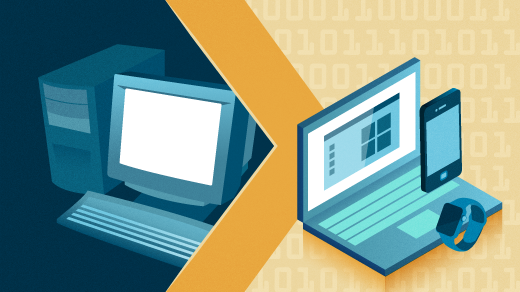Setting Up A Dual-Boot System On A Desktop

In the world of desktop computing, having the ability to run multiple operating systems on a single machine can open up a world of possibilities. Whether you’re looking to experiment with different software, or simply need to access programs that are only compatible with a specific OS, setting up a dual-boot system on your desktop can be a game-changer. In this article, we’ll explore the ins and outs of creating a dual-boot system, and provide you with all the information you need to get started on this exciting journey.
Related: Buy Best Desktops in Oman
Setting Up a Dual-Boot System: A Comprehensive Guide
Setting up a dual-boot system on a desktop can be an incredibly useful and efficient way to maximize your computer’s capabilities. Whether you need to switch between operating systems for work or personal reasons, this comprehensive guide will walk you through the process step by step, ensuring a smooth and successful setup.
1. Decide on the Operating Systems
The first step in setting up a dual-boot system is to decide which operating systems you want to install on your desktop. Consider your needs and preferences, whether it’s Windows and Linux, macOS and Windows, or any other combination. Make sure to check the system requirements for each operating system to ensure compatibility with your desktop hardware.
2. Prepare Your Desktop
Before diving into the installation process, it’s crucial to prepare your desktop for the dual-boot setup. Here are the key steps to follow:
- Back up your data: Before making any changes to your system, it’s essential to back up all your important files and data. This will ensure that you don’t lose any information during the installation process.
- Partition your hard drive: To accommodate multiple operating systems, you’ll need to partition your hard drive. This involves dividing your disk space into separate sections for each operating system. Use a reliable partitioning tool to create the necessary partitions.
- Create bootable installation media: Obtain the installation media for both operating systems, whether it’s a USB drive or a DVD. Follow the instructions provided by the operating system’s manufacturer to create bootable media.
By following these initial steps, you’ll be well on your way to setting up a dual-boot system on your desktop. Stay tuned for the next part of this comprehensive guide, where we will delve into the installation process in detail, ensuring a successful and hassle-free setup.
Understanding the Benefits and Considerations of a Dual-Boot Setup
Setting up a dual-boot system on a desktop can offer a wide range of benefits and considerations that are worth exploring. One of the main advantages is the ability to have multiple operating systems on the same machine, allowing users to switch between them based on their needs. This can be particularly useful for individuals who work with different software or have specific preferences for certain tasks. Whether you’re a developer who needs to test applications on different platforms or simply a user who wants to try out a new operating system without fully committing, a dual-boot setup provides the flexibility you’re looking for.
Another benefit of a dual-boot system is the enhanced security it can provide. By separating your personal and work environments into different operating systems, you can ensure that any potential security breaches or malware attacks are contained within one system, minimizing the risk to your other files and data. This can be especially important for individuals or businesses that handle sensitive information or work with confidential data.
However, it’s important to consider some factors before diving into a dual-boot setup. First and foremost, make sure you have enough storage space on your hard drive to accommodate multiple operating systems. Each system will require its own partition, and having insufficient space can lead to performance issues. It’s also crucial to back up all your important files before proceeding, as there is always a risk of data loss during the installation process. Additionally, keep in mind that managing and maintaining multiple operating systems can be time-consuming and may require a certain level of technical expertise.
In conclusion, setting up a dual-boot system on a desktop can offer various benefits and considerations. It provides the flexibility to switch between different operating systems, enhances security by separating personal and work environments, but also requires sufficient storage space and technical knowledge to manage effectively. Whether you’re an avid technology enthusiast or a professional seeking optimal performance and versatility, a dual-boot setup might be the perfect solution for you.
Step-by-Step Instructions for Setting Up a Dual-Boot System on Your Desktop
One of the most efficient ways to optimize your desktop’s capabilities is by setting up a dual-boot system. With a dual-boot system, you can have two operating systems installed on your desktop, allowing you to switch between them as needed. Whether you want to have both Windows and Linux, or Windows and macOS, this step-by-step guide will walk you through the process of setting up a dual-boot system on your desktop.
Step 1: Plan Your Setup
Before diving into the installation process, it’s crucial to plan your setup carefully. Determine which operating systems you want to install and allocate sufficient disk space for each. Consider the compatibility of your hardware with the chosen operating systems and ensure you have the necessary installation media or ISO files. It’s also recommended to back up your data to prevent any potential loss during the installation process.
Step 2: Prepare Your System
Once you have a clear plan, you need to prepare your system for the dual-boot setup. Start by creating a bootable USB or DVD for each operating system you want to install. Then, partition your hard drive to allocate the necessary space for each operating system. Use a partitioning tool, such as GParted, to resize your current partitions and create new ones. Make sure to leave enough space for both operating systems and any additional programs you want to install.
Next, disable any secure boot settings in your BIOS to allow for the installation of non-Windows operating systems. This step may vary depending on your system, so refer to your motherboard’s manual or manufacturer’s website for specific instructions. Finally, ensure that your system is running the latest firmware and drivers to avoid any compatibility issues during the installation process.
By following these step-by-step instructions, you’ll be well on your way to setting up a dual-boot system on your desktop. Enjoy the flexibility and freedom to switch between different operating systems, enhancing your productivity and exploring new possibilities.
Recommendations for Optimizing and Managing a Dual-Boot Configuration
One of the key aspects of optimizing and managing a dual-boot configuration is to ensure that both operating systems are properly installed and updated. This can be achieved by following a few simple steps. Firstly, it is important to partition the hard drive correctly, allocating enough space for each operating system. This can be done through disk management tools or third-party software. Once the partitions are set up, it is crucial to install each operating system separately and ensure that all necessary drivers and updates are installed. Regularly checking for updates and installing them promptly is essential for maintaining a stable and secure dual-boot configuration.
Another recommendation for optimizing and managing a dual-boot configuration is to carefully manage the boot menu. The boot menu is the screen that appears when the computer starts up, allowing the user to select which operating system to boot into. To optimize this process, it is recommended to prioritize the default operating system, ensuring that the desired system is automatically selected if no user input is provided. Additionally, removing unnecessary operating systems from the boot menu can help streamline the boot process and reduce confusion. This can be done through the operating system’s boot configuration settings or through third-party software. By carefully managing the boot menu, users can optimize their dual-boot configuration and ensure a smooth and efficient boot process.
Below is an example of a table comparing the key features of two popular operating systems:
| Operating System | Windows | Linux |
|---|---|---|
| Cost | Commercial | Open-source (usually free) |
| Software Compatibility | Extensive | Varies depending on distribution |
| Customizability | Limited | Highly customizable |
| Security | Antivirus required | Generally more secure |
By considering these recommendations and properly optimizing and managing a dual-boot configuration, users can enjoy the benefits of having multiple operating systems on their desktop without encountering major issues or inconveniences.
Final Thoughts
In conclusion, setting up a dual-boot system on a desktop can open up a world of possibilities for users who want to experience the best of both operating systems. Whether you’re a fan of Windows or a devotee of Linux, having the option to switch between the two on the same machine can offer flexibility and convenience. By following the steps outlined in this article, you can embark on the journey of creating your own dual-boot setup and enjoy the best of both worlds. So, don’t be afraid to take the plunge and explore the endless possibilities of a dual-boot system on your desktop. Happy dual-booting!



